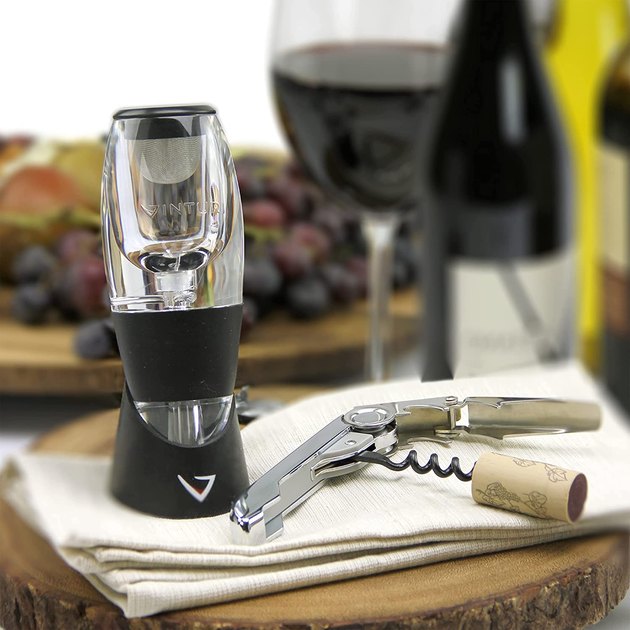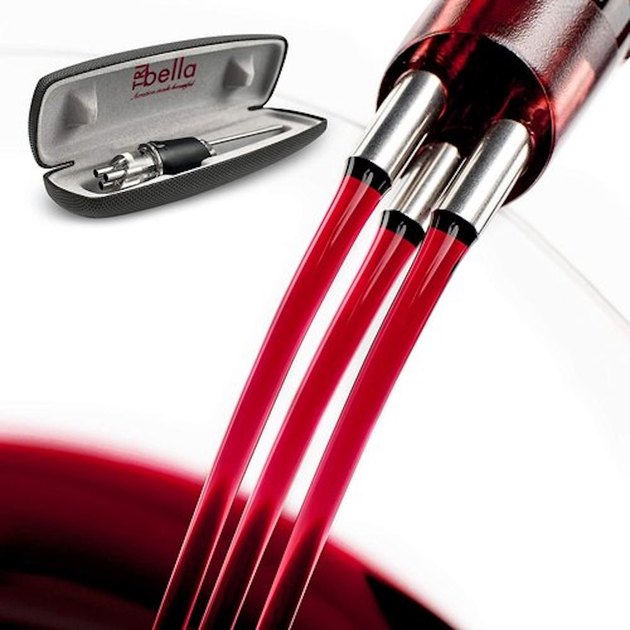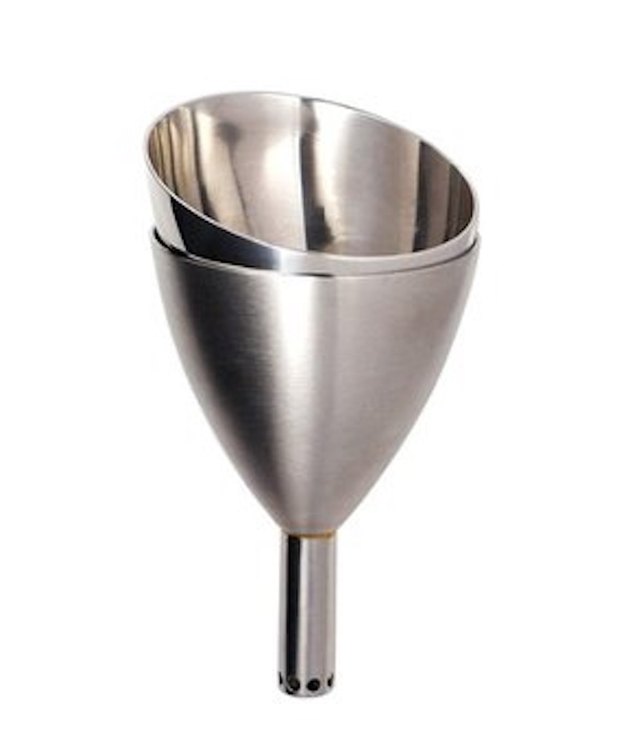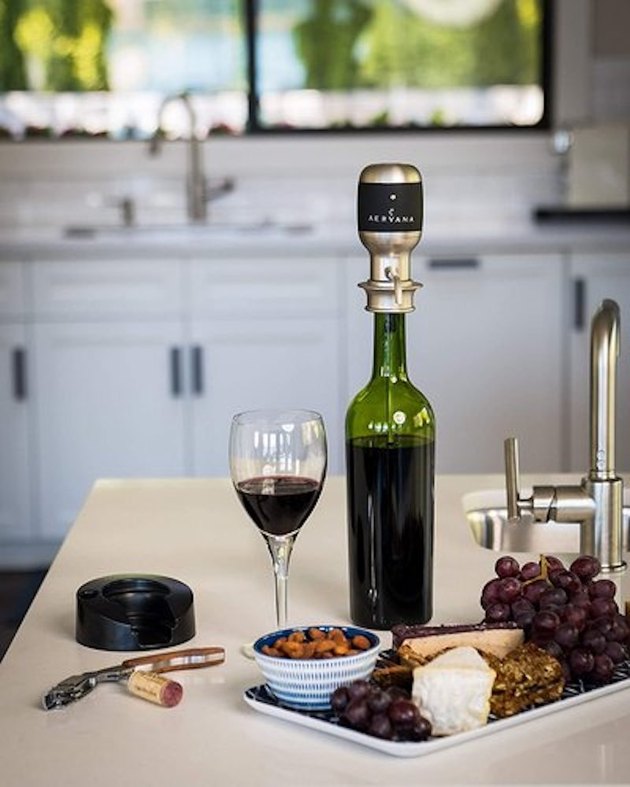
A bottle of wine isn't usually at its best when it's first opened. Most need a bit of time to "breathe," which simply means allowing oxygen to interact with the wine and bring out its character. You can speed the process by pouring your wine into a decanter, which allows a lot more air to come into contact with the wine. Alternatively you can buy one of the many modern wine aerators, designed to cut the aeration process down to just a few moments. A well-chosen aerator can help tame the tannins and bring out the aromas in high-quality wines, and improve your overall wine drinking experience. We've picked out a half-dozen of the best for your consideration.
What to Consider When Purchasing a Wine Aerator
Video of the Day
A decanter is the original wine aerator, but you'll typically need to leave your wine in the decanter for at least 30 minutes and often a few hours, depending on its design. That makes them less flexible and versatile than newer designs. For one thing you're committed to decanting and drinking the entire bottle, and—just as importantly—if you decide to open another bottle of wine, you're starting from scratch again. Aside from this basic question (decanter versus true aerator) there are a few other things you should consider.
Video of the Day
The Age and Quality of Your Wines: Most red wines will benefit from a bit of aeration, but some—usually the biggest and most complex—benefit more. Paradoxically, wines that have been cellared for a while (largely in that same style, but older) may be aerated too much, too quickly, by some devices and lose some of their delicate aromas and fine qualities. A few white wines and dessert or aperitif wines that may benefit from aeration, though they're less-known.
Your Intended Use: Do you want an aerator you can take with you on that bucket-list trip to Napa or the Loire Valley? Something that will look good sitting on your bar or sideboard? A high-tech tool to absolutely maximize your investment in top-tier wines? That will dictate the size and format of your aerator, and may have an impact on your budget as well.
Special Features: Aerating wine may not be the only thing on your mind. Some aerators provide additional functionality, from helping remove sediment and cork debris to helping preserve your now-opened bottle in the best possible condition. Considerations like those can help shape your purchasing decision.

The Best Overall Wine Aerator
Vinturi is the company that more or less created the entire category of wine aerators, and this is its bedrock product. It's a sleek oblong, roughly the size of a soda can but tapered for an easy grip. It'll fit neatly into your purse or luggage, but not so well in a pocket. As for ease of use, the Vinturi is hard to beat: To use it, you simply hold it over your glass and pour in the wine. Your wine runs through a mesh screen that removes sediment and stray bits of cork, then through Vinturi's patented aeration chamber and into your glass. The wine makes a characteristic whooshing, gurgling noise that you'll recognize immediately once you've heard it, and makes it easy to spot off-brand imitators. By the time you're finished pouring, your wine is ready to drink. You can purchase the Vinturi on its own or bundled with a stand for one-handed pouring, and there's a separate version of this aerator designed for white wines.
The Best Aerating Pourer
If you're looking for something more pocket-friendly that still gets the job done, Tribella's Classic Wine Aerator might be just the thing. Most aerating pourers consist of a pouring spout that attaches to the bottle and in some way incorporates air into the wine as it runs through the spout. The Tribella takes a different tack, dividing your wine between three separate stainless steel pouring spouts. This sharply increases the wine's exposure to oxygen as it cascades into your glass. You can control the amount of aeration by raising the bottle farther above your glass as you pour. The streams simply stop, with no drips, as soon as you tip the bottle back.
The Classic Wine Aerator is small enough to fit into a reasonably-sized pocket (it's four inches long, and one-half inch in diameter) and comes with a carrying case that looks much like the one you use for your eyeglasses. Its combination of functionality and aesthetics (the three streams are more visually pleasing than you'd think, and bring some showmanship to the process) make it a solid winner. If you're a wine-lover on a budget, it's worth noting that there's a lower-priced version (the "Air Speed" model) using polycarbonate spouts rather than stainless steel, at about half the price.
The Best Aerating Funnel
Funnel aerators work in much the same way as our top pick, Vinturi aerator: You pour the wine through them, and the wine is aerated as it passes through the funnel. The difference is that while the Vinturi and its competitors are designed to add air to the wine as you pour it into your glass, an aerator funnel is used when you're filling a decanter. Instead of aerating wine over the period of an hour or two, it takes just moments.
This funnel from Rabbit, a respected maker of accessories for wine lovers, is a perfect example. It's made from durable stainless steel, it's dishwasher safe and contains a removable nested strainer to remove sediment and bits of cork (the other main reason for decanting). Just drop your funnel into the top of the decanter and pour the wine through. As it leaves the bottom of the funnel it's routed through a series of holes at the funnel's bottom, which shower the wine down the sides of your decanter for rapid aeration. When you're done, give it a quick rinse and drop it into your dishwasher. It's not pocket-friendly, but it's really intended for home use (because that's where your decanter is, right?).
The Best Electric Aerator
For bottles with a lot of sediment gathered at the bottom, the very act of pouring a glass of wine will stir it up (with or without an aerator). One of the virtues of the Aervana electric wine aerator is that you don't need to move the bottle to pour yourself a glass. This aerator/dispenser wedges onto the top of your bottle, which remains safely on the table or counter. When you want to pour and aerate your next glass of wine, the tiny and near-silent electric pump in the Aervana will dispense it at the push of a button. Any sediment remains behind, at the bottom of the bottle, where it belongs.
The Aervana runs on six AAA batteries, which should last for approximately 100 bottles. The telescoping stainless steel tube that feeds wine into the pump extends so you can use the device on oversized 1.5 liter bottles as well as standard sized 750 ml bottles. The company also makes a deluxe model with adjustable aeration—very handy for those who routinely open older wines—but for most of us, the Aervana Original will work just fine.
The Best Wine Decanter
There are plenty of good wine decanters out there, and most of them will aerate your wine well enough over time. Üllo's "wine purifier" and decanter bundle goes well beyond that basic level of functionality. The carafe itself is high quality (mouth-blown, lead-free crystal) and gives your wine plenty of surface area for natural aeration, but the star of the show is the aerating filter that comes with it. It's a multi-purpose gadget: In a single pour it can aerate your wine; cool it to perfect cellar temperature in seconds; and—most importantly—it filters sulfites from your wine.
Sulfites occur naturally in wines, but they're also deliberately added as a preservative. Many people, including the Üllo's inventor, are sensitive to those, so filtering out the sulfites (and allergy-inducing histamines) means people with those sensitivities can once again enjoy red wines. More importantly, it makes the wine taste better for everyone. Its only downside is that the sulfite filtration requires single-use filters, which are sadly much costlier than the ones you use in your coffee maker.
The Best Wine Aeration/Preservation System
Coravin's business model mostly revolves around the opposite of aeration: Their system is designed to preserve wine after it's been opened, stopping oxygenation in its tracks and preserving the quality of your favorite wine until the next time you pour a glass. It's an investment only serious wine lovers will make (Coravin systems start at over $100 and can push the $500 mark), but it's absolutely worthwhile if you regularly splurge on high-end Cabernet Sauvignon and other Very Serious Wines.
If you already have a Coravin system, or are thinking of getting one, adding this modestly priced aeration accessory is a no-brainer. It simply attaches to the spout of any Coravin wine dispensing and preservation system, which pumps inert argon gas into the bottle and forces the wine out. As the wine comes through the spout, it passes through the aeration accessory and aerates on its way to your glass. The aerator adds little to the overall cost of a Coravin system, and if you buy quality wines the system will pay for itself with surprising speed through reduced wastage.





